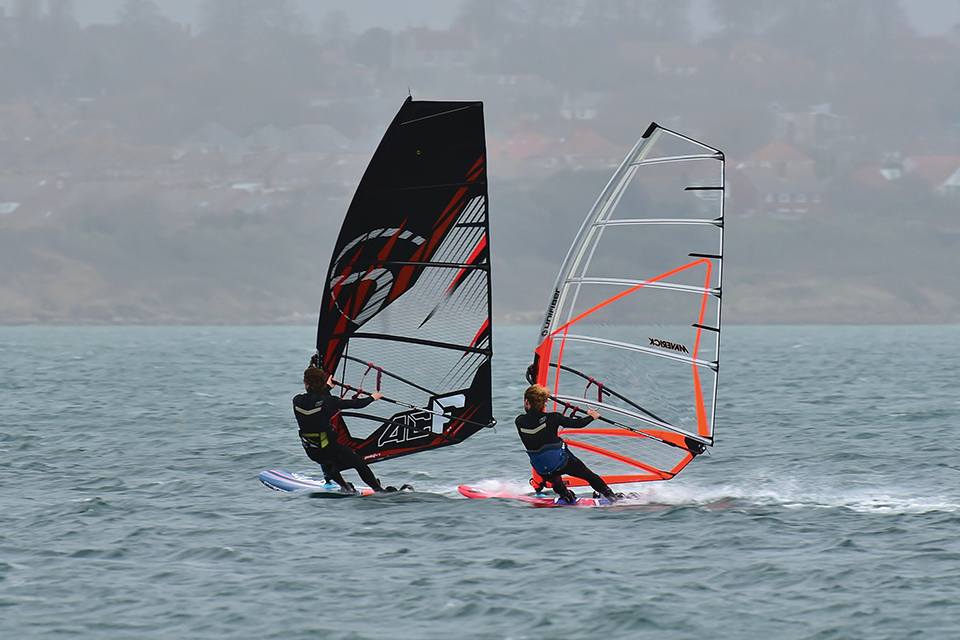UNDER STARTERS ORDERS
6.5M ENTRY-LEVEL FREERIDE SAIL TEST 2019
Test Editor Tris Best // Second Testers Maurin Rottenwalter & Joe North
Photos Tris Best & Andy Stallman // Test location Portland Harbour.
This is the first occasion we’ve had an entry-level freeride sail category in our test schedule, which left our test team asking the most basic question, “What is required of an ideal first-time freeride engine?” And if the parameters are agreed and set, which of them should be prioritised? Ease of rigging and ease of use? Cost and affordability, or durability and range? Over to the team to expand.
This test was originally published in the May 2019 issue.
FINDINGS
Last month we reviewed the very latest no-cam freerace sails on the market; sails that are easy to rig and free from the complications of cams … yet designed to cope in overpowered conditions, with enough performance on tap to satisfy even the most fanatical speed nut! So this month we jump to the other end of the spectrum, looking at the best power source for the novice rider taking their first steps into planing conditions. The first consideration therefore has to be ease and practicality of the sail’s rigging. It should be a cinch to put together and require little effort or knowledge. Better still, the sail should have a wide tuning target and natural range, meaning that it is forgiving and easy to use, even if rigged poorly.
Last month we were largely looking at top end control, speed and efficiency in the sails we tried … yet for these entry-level freeride sails, a key attribute would be bottom end power (the ‘torque’ generated at low speeds), and a forgiving delivery. 6.5m is a good ‘first sail’ size for an average weight adult to consider. The sail needs to be big enough to provide early planing power in inviting wind strengths (roughly Beaufort force 4), yet remain small and manageable enough for the inevitable regular uphaul. Ladies and youths may well want to opt for a smaller sail size, whilst larger riders could go bigger. But the brief is simply to generate easy accessible power, remaining light and balanced in the hands. Reduced luff curves, fewer battens and a discard of unnecessary detailing is a given, these are distilled designs, with ease and practicality at their heart. And since they have less ‘bells and whistles’, their prices have been brought down accordingly as well. There is always a risk by branding an item with a price-related tag that the wrong message is conveyed. Whether it be budget, value, price-pointed or otherwise, the worry is that the end user believes that corners in development or fabrication have been cut. And yet, this test proves otherwise. Sure, some of the sails are ‘lightweight’ when it comes to niceties and ‘decoration’, but they are strong on their functional quality and form. The testing for this review took place during a period when the British Isles was being battered by storm after storm, so we had to pick our days to get out on the water. But it is fair to say we were impressed with the performance range available, allaying the fears we initially had upon first inspection of some!
One last point worth noting is that all bar one of these sails was supplied with a high carbon content (91% or more) mast for testing. There’s a very good reason for this, as it has been proven time and again that a quality mast will improve your whole windsurfing experience. The downside is that a mast is such a dull item of kit to buy, and you can spend upwards of £400.00 plus on what is essentially a long carbon stick! When we discuss buying equipment with people on a course at the OTC centre, we always advise buying as high a carbon content mast as they can afford – one of 75% or more would be ideal. The weight saving is one key positive, but more so than this, the quicker response time of a quality mast makes the sail feel light and more active in the hands, as well as increasing the sail’s usable range. In short it forms the backbone of your riding enjoyment! The performance of the 40% carbon mast used in this test was noticeable in marginal winds, yet largely annulled once powered, simply by the quality of the sail it accompanied.
SUMMARY
The nine sails in this test all perform well, yet have individual qualities that distinguish them from one another. The Severne Convert is a good place to start. With such an upright stance it feels light and responsive, its elastic stretch providing a very forgiving delivery. It is best suited for light to medium weight riders and comfortably powered conditions. The RRD X-Tra is also incredibly light and manageable in handling, sharing a similar dropped clew geometry to the Severne. It differs though, because its pull comes from low down, matched with a tuning range to extend its top end capabilities. If you’re an ambitious novice or more experienced, the efficiency and crispness of the X:Ryde from Neil Pryde might take your fancy. Not really entry freeride as such, it is the priciest option here, but has the performance to warrant it. Next to step up are three true all-rounders. The Duotone E_Type, GA Hybrid and Simmer Enduro are all stunning options, that can guide you through your first planing steps and remain loyal in service well beyond. The E_Type has more of a blasting outline with its six battens; the Hybrid is more neutral in transition and the Enduro is the most versatile in stance and application. All of them come from highly reputable lofts and would do a new owner proud. That brings us onto the powerhouses of the group – the Ezzy and Point-7. Both generate plenty of power through the hands, but by very different methods. The Legacy champions pre-shape and deep profile; the AC-F goes for shear size and over-proportion. Both would find favour with the rider that just loves to be kept involved throughout their time on the water. And finally we get to the Unifiber Maverick – easily the most affordable sail in this group. If you judge it by its appearance, you’d be excused for believing it would fold in two when the wind picks up … and yet nothing could be further from the truth. Such a good feeling sail to use, its modern shaping and quality shines through, even in some challenging conditions.
THE LINE UP


